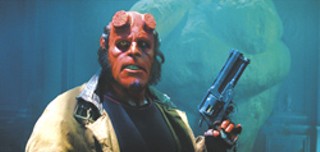Hellboy II: The Golden Army
Cinematic superhero sagas have suddenly become a dime a dozen -- a moviegoer can’t turn around without one swooping down from the multiplex screen -- yet while Hellboy II: The Golden Army is worth more than a plugged nickel, it still ranks among the more disappointing of these countless comic book adaptations that, if nothing else, have given purpose to the lives of fanboys across the country (that purpose, of course, being to bash anyone who doesn’t completely share their views). That Hellboy II fails to deliver the goods is a real shame: While most of writer-director Guillermo del Toro’s earlier titles have been noteworthy (including The Devil’s Backbone and the underrated Mimic), his Oscar-winning Pan’s Labyrinth suggested that he had firmly entrenched himself in the ranks of the top-tier filmmakers working today (not at the level of Spielberg or Scorsese, of course, but certainly equal to Peter Jackson). Yet while this sequel to the 2004 feature (itself based on Mike Mignola’s comic series) doesn’t lack for visual wonders, it’s utterly clumsy in the storytelling department, a genuine shock given del Toro’s usual ability to spin a tall tale. Here, Hellboy (Ron Perlman), the satanic emissary who fights on the side of right, must face off against Prince Nuada (Luke Goss), an albinotic, ancient leader who hopes to revive the Golden Army to destroy humankind. The lumbering brutes who comprise the army are pretty cool, though they’re overshadowed by del Toro’s other monstrous creations, including a gigantic plant-man who crashes through the New York streets like a “Go Green” Godzilla and Tinkerbell-sized fairies whose collective appetite suggests nothing so much as a school of barracudas. The original Hellboy wasn’t anything special, either, but at least the predicament of its red-hued hero carried some dramatic heft, particularly in the way his feeble wisecracks masked the painful ache in his soul, a loneliness that could only be cured by the love of another mutant, the pyrokinetic Liz (Selma Blair). Del Toro miscalculates this time around by moving the pair too quickly to the status of bickering, boring lovers. Their relationship is almost as poorly developed as the budding one between fishman Abe Sapien (returning Doug Jones) and Prince Nuada’s sister, Princess Nuala (Anna Walton). And it doesn’t help any facet of the film that Nuada and Nuala are drab, lifeless characters whose physical appearance turns them into His and Hers versions of Edgar Winter. For all its cool critter content -- a mishmash of the Harry Potter adventures, The Neverending Story and del Toro’s own back catalogue -- Hellboy II is surprisingly snooze-inducing when it comes to its storyline and even its central characters. There’s an aloofness to the whole enterprise that’s atypical for the director, suggesting that maybe his mind was already racing ahead to future projects. Then again, with The Hobbit on his plate, that was probably to be expected.
Journey to the Center of the Earth
Ever since the 3D process first appeared in cinema in 1952’s Bwana Devil (advertised with the tagline, “A lion in your lap! A lover in your arms!”), filmmakers have attempted to turn this innovative technique into more than just a fad that appears at regular intervals over the years. 1953’s Vincent Price chiller House of Wax arguably remains the most famous of all three-dimensional efforts (further containing the most iconic of all 3D images, that of the street barker bopping his paddleball right into moviegoers’ faces), though I imagine the 1969 softcore smash The Stewardesses 3D also has its ardent supporters. But poorly produced movies like Jaws 3-D and Friday the 13th Part III did little to advance the cause -- donning the requisite spectacles only resulted in muddy colors bleeding on the screen -- and it wasn’t until last year’s Beowulf that the technology was finally perfected. Seeking to build upon Beowulf’s breakthrough, Journey to the Center of the Earth takes the 3-D ball and runs with it. In presenting this tale of a scientist (Brendan Fraser) who discovers that Jules Verne’s classic novel is more fact than fiction and subsequently travels beneath the surface with his surly nephew (Josh Hutcherson) and their hottie guide (Anita Briem) in tow, the filmmakers throw everything but a three-dimensional kitchen sink at us: a dinosaur’s snapping jaws, prehistoric piranhas’ pointy teeth, oversized Venus flytraps, bouncing balls, a protruding tape measure, even spittle. It’s all rather nifty, but the problem is that the majority of movie theaters are not showing the picture in 3-D (most multiplexes don’t have the capability yet). And whereas House of Wax and Beowulf remain entertaining yarns when watched in the normal, flat format, this Journey is so insipid that it’d be a chore trying to sit through the simple-minded narrative without the added incentive. As for Fraser’s overacting, he’s such a ham that his eyes pop out of the screen even more menacingly than those sharp dinosaur choppers.
Meet Dave
How many times have we moaned about how “all the best parts were shown in the trailer”? Meet Dave takes the opposite stance: Based on the preview, this vehicle for Eddie Murphy looked as if it would compete with The Love Guru in the sheer awfulness department. And make no mistake: What’s presented is still pretty bad. But compared to Mike Myers’ toxic effort, this almost comes off as Annie Hall by comparison. What the trailer doesn’t convey is that Murphy actually delivers a sharp comic performance as Dave, a human-shaped-and-sized spaceship powered by the tiny aliens within. He also plays the diminutive captain of the spacecraft, but he isn’t especially memorable in this dry role, spending much of the time alternately wooing a fellow shipmate (Gabrielle Union) and a friendly Earthwoman (Elizabeth Banks, who earlier this year co-starred in the similarly titled Meet Bill), as well as slowly learning that our planet and its inhabitants are capable of offering compassion and beauty and great movies like It’s a Wonderful Life. It’s Murphy’s work as the walking, talking spaceship that’s inspired, as the character amusingly reacts to the surplus of confusing information flooding his system (as when Banks’ Gina announces that they’re eating meatloaf for dinner and the ship’s computer brings up images of the burly rocker).Unfortunately, Murphy far outshines the material, which mixes the usual bodily-function gags with the usual last-minute sanctimonious pleas for compassion and open-mindedness.


























